Girl Groups
[DVD]
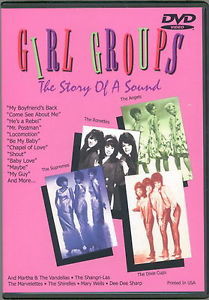
view/request
This rare, long out of print copy of Steve Alpert and Stephanie Bennett’s 1982 film provides a joyous glimpse into the history and development of the girl group sound. In addition to candid interviews with key figures like Darlene Love, Mary Wilson, Ronnie Spector, Arlene Smith and Ellie Greenwich, the film includes rare performance footage discovered by the filmmakers in the damp basement of a local TV affiliate in Windsor, Canada. These clips and performances by seminal groups of the era were originally aired on Teen Town, Detroit’s local version of American Bandstand. The film traces the history of the girl group sound from song writers in the Brill Building in New York to Motown and beyond, and includes clips of the Ronettes, Martha and the Vandellas, the Shangri-Las, the Marvelettes, the Angels, the Dixie Cups, the Shirelles, Dee Dee Sharp and a rare short color film of the Exciters bizarrely miming “Tell Her” in the general direction of lions and bears in a zoo. The film quality is certainly dated and shows it’s age in places, and a segment on the Supremes runs perhaps a bit too long (Motown required a minimum of ten songs to be featured for the rights to the Supremes) while other important groups are barely mentioned. All things considered, the interview segments and performances more than make up for these faults and the film stands as a valuable artifact of the times, and must viewing for fans of the Girl Group Sound.
Reviewed by Dylan
Tagged: Documentary, Pop music, Rock music, Soul music
Henning Goes to the Movies
by Henning Ohlenbusch
[Music CD]

view/request
Please excuse the following burst of textual immodesty… Ahem. As founder and president (not to mention CEO, secretary, vice president & mascot) of the Forbes Film Club, I can safely say that I know a thing or two about the cinema. In addition, it was in college where I studied video and film, wrote lengthy ramblings dealing with issues within the worlds of documentary film and German cinema, composed pretentious screenplays and starred in some student produced shorts that feature poor lighting (often typecast as a chat show host, bud did sport a tricorne hat once for a period piece). I later found myself in Texas working in a video library/archive and spent most evenings devouring the collection and attending curated film festivals. To this day, little gives me greater pleasure than sitting in the theater, munching on popcorn and seeing something unfold on the big screen.
I have very personal connections to a handful of films and I believe movies we love can have a great impact on how we define ourselves. This is why Henning Goes to the Movies is so appealing.
Nine movies. Nine songs. Henning Ohlenbusch, lyricist extraordinaire/singer/songwriter of the group School For the Dead, is the architect (perhaps I should use director in this instance?) behind this wonderful album. He sings about the hilariously raunchy Super Bad, David Lynch’s quiet drama the Straight Story, the horror classic Poltergeist, the coming of age classic the Year My Voice Broke and more. His approach to these pieces is not a highlight of important plot points; rather he shares his personal experience with each film. Through introducing a specific character’s perspective or providing an overall sentiment of a movie, Ohlenbusch invites the listener to go on a cinematic journey.
His folksy pop songs are simply arranged to bring us close to the stories. He also tastefully sets the scene with appropriate backing. We find ourselves somewhere in the distant future in Logan’s Run with weaving backward electric guitar and at an old time carnival in Joe Vs. the Volcano. Though voice and acoustic guitar tend to be in the forefront throughout, keyboards, glockenspiel, subtle effects, electric bass, harmony vocals and percussion expand the mix.
This a great collection of songs, even without the movie theme. And I should mention that you really don’t need to have seen the films to appreciate the record. It is, however, even more of a gratifying listen for those of us who find that films are an important fabric of our lives.
Reviewed by Jason
Tagged: Film, Folk music, Pop music, Rock music
The Bones of All Men
by Philip Pickett and Richard Thompson
[Music CD]

view/request
This album marries two of my favorite genres of music: specifically, 16th century Renaissance dances and British folk-rock of the 1960s and ’70s.
Richard Thompson and some ex-Fairport Convention comrades joined conductor and multi-instrumentalist Philip Pickett (who has Albion Band credentials as well as early music) in 1998 to rock out on a selection of tunes by William Byrd’s contemporaries. When I used to play electric harpsichord for English Country Dancing back in the early ’90s, this was the sort of sound I dreamed of achieving. Imagine a note-perfect recorder consort accompanied by Dave Mattacks on drums, or dueling krumhorn and electric guitar, or virginal with a very electrified bass continuo. The tunes are brilliantly arranged, irresistibly driving, reverently irreverent (or vice versa), passionately fun and absolutely classic in every sense of the word. Turn it up, way up.
Reviewed by Faith
Tagged: Early music, Rock music
Return To Cookie Mountain
[Music CD]
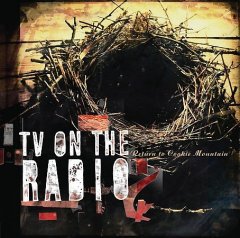
view/request
Return To Cookie Mountain (2006), by the Brooklyn-based quintet TV On The Radio, was my introduction to this group’s music and I quickly became a fan. I really enjoy the unique harmonies and vocal layerings of the two primary vocalists Tunde Adebimpe and Kyp Malone. The melodies are also exceptional and have been described as “atmospheric” and “spacious” Their music is not easy to categorize but some close approximations include: indie-rock, soul and trip-hop. Repeated listenings to this CD always reveal more pleasurable discoveries of their unique sound. Two outstanding tracks for me are “I Was A Lover” and “A Method”.
Reviewed by Susana
Tagged: Indie rock, Rock music
A Wizard, A True Star
by Todd Rundgren
[Music CD]
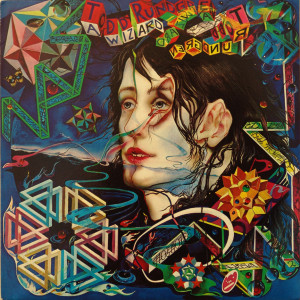
view/request
Todd Rundgren, hot off the heels of Something/Anything? and its hits “Hello It’s Me” and “I Saw the Light”, released an experimental album called A Wizard, A True Star in 1973. The record is a strangely assembled pastiche of synthesizer driven pop songs, homages to Disney soundtracks and wacky Spike Jones records, soul covers and dark, personal compositions.
Nearly all of the songs run together on this recording creating a frantic, but inspired listening experience. Ever the innovative musician and producer, Rundgren’s engaging arrangements and subtle overdubs make this record a gratifying headphone listen.
Reviewed by Jason
Tagged: Experimental, Rock music
Spooked
by Robyn Hitchcock
[Music CD]
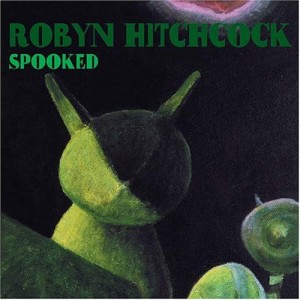
view/request
In 2004, Robyn Hitchcock recorded one of his finest albums with folkster heroes Gilllian Welch and David Rawlings. The trio set up shop in Nashville, TN and created this very sparse and absorbing recording. The album is filled with rich textured harmonies, picking acoustic guitars and a refreshing amount of open space. Though mostly an acoustic record, the album also features spots of electric piano, minimal drums, electric sitar for psychedelic touches and Eastern flavor and a couple electric bass guest spots by NRBQ man Joey Spampinato.
On the dobro led “We’re Gonna Live in the Trees”, Hitchcock’s famed clever lyrics bounce the literary reference of Virginia Woolf had a troubled mind, it was never at ease with the song’s title/refrain. He also shows a softer side with the slow and outer-spacey “English Girl”. Her skin was clear and her mum wore pearls/I fell in love with an English girl/ She asked me for an almond whirl/ I was obliged to the English girl.
Robyn Hitchcock is one of the few recording artists whose catalog has remained consistently inspired throughout a lengthy career. Spooked, in particular, stands out from his recent output due to the stunning contributions from Welch and Rawlings.
Reviewed by Jason
Tagged: Folk music, Music, Psychedelic, Rock music
Nilsson Schmilsson
by Harry Nilsson
[Music CD]

view/request
Though RCA records proudly proclaimed, “Harry’s Got a Rock Album” upon the release of 1971’s Nilsson Schmilsson, it’s safe to say Mr. Nilsson had dabbled in rock n’ roll previously. However, his output mostly belonged in the vaudeville and light psychedelic, Sgt. Pepper stratosphere. After his first album, the mysterious solo artist was cited as the Beatles favorite “group”. He followed with two strong lps; one includes his version of Fred Neil’s “Everybody’s Talkin’” (which wound up as the Oscar winning vocal performance for the film Midnight Cowboy). Next Nilsson jumped into an album completely of Randy Newman material (then a mostly unknown songwriter) just before releasing a story and song record that later became the animated classic The Point.
Producer Richard Perry, who had received critical acclaim for his work with Tiny Tim, assembled Klaus Voormann, Jim Price, Jim Gordon, Herbie Flowers, Jim Keltner and other notable session musicians for the London Nilsson Schmilsson sessions. The tracks proved to be heavier than what was expected from the Harry of old (see the seven minute “Jump Into the Fire”), but we still have the necessary ingredients for a classic Nilsson recording: his amazing three octave range, sense of humor and delightful arrangements. A cover of Badfinger’s “Without You”, the ridiculous one chord, beatnik jam that is “Coconut” and the dreamy “Moonbeam Song” help rank Nilsson Schmilsson as one of Harry’s most memorable.
Incidentally, the progression into rock n’ roll wasn’t Nilsson’s last metamorphosis. As the 1970’s trucked on, our hero dabbled in lush standards from the 1930’s and 40’s, steel drum music, comedy tracks and songs about… well, writing songs among other things. It was a career spent confounding critics and delighting fans. Well played.
Reviewed by Jason
Tagged: Rock music

view/request
I have a friend who lives in Austin, TX who is constantly making me jealous. She likes to mention, with a trace of blasé, that she’s just seen some amazing rock, soul, blues, country or hip-hop artist perform just down the street from her house. Earlier this year, she recommended the Austin group Harlem (she had seen them perform live down the street!) and after listening to some songs online, I was hooked. I ordered the lp right away and suggested ordering a copy for Forbes.
Harlem plays straight, unabashed garage rock without any pretension whatsoever. Catchy melodies and the spirit of rock n’ roll dominate their debut full-length recording. I’ve deduced that this ramshackle trio loves the following: reverb, switching instruments, collaborating on songs and getting down.
Living in the Valley, we may not have the luxury to walk to Harlem’s next show, but we can certainly enjoy this recording from our living room.
Reviewed by Jason
Tagged: Music, Rock music
Ginger Geezer: The Life of Vivian Stanshall
by Lucian Randall and Chris Welch
[Book]
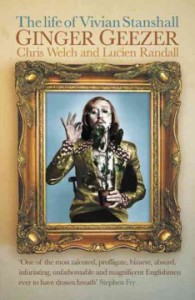
view/request
“You got a light, mac? No…but I’ve got a dark brown overcoat.”
Vivian Stanshall, sousaphone player, ukulele maestro and vocalist extraordinaire, practicer of elaborate practical jokes, rubber ears sporter and snake owner, certainly lived up to the oft dubbed title as the “great British eccentric”. Oh, and he lived on a boat.
He and his colleagues from the Bonzo Dog Doo-Dah Band created the most wonderfully silly, chaotic and beautiful music know to man by melding 1930’s jazz and novelty numbers, psychedelic rock, Python-esque comedy and Beatles arrangements. To my knowledge, this group is the only group to list wah-wah rabbits as an instrument on a recording. Stanshall shared most of the lead vocal duties with Neil Innes (later found in the Rutles), but it was the former who was the expert frontman and instigator of this riffraff outfit.
Stanshall’s biography delves into the life of this complicated character before and after his run with the Bonzos. Fame, family life, alcoholism, brilliant radio projects (including “Rawlinson’s End”), madcap stunts and the slow decline of spirit helps makes Ginger Geezer paint a mighty confounding portrait. Viv wouldn’t have had it any other way.
Reviewed by Jason
Tagged: Biography, Comedy, Non-fiction, Rock music
Ram
by Paul & Linda McCartney
[Music CD]
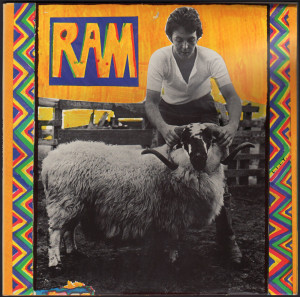
view/request
“Ram on give your heart to somebody…soon right away, right away,” McCartney laments on the ukulele driven “Ram On”. Ram, the sole album credited to Paul & Linda McCartney, is truly a family affair with half of the songs credited to the couple. Despite several tunes with surreal, nonsensical lyrics, Ram seems to give us a window into a simpler life. There’s numbers about dogs, the desire to live in the country and young love.
While retaining an element of the homemade sound McCartney crafted on his debut record, the pair also delve into Beach Boys arrangements and harmony as well as exploring something I’d like to call easy-listening/avante garde (see “Uncle Albert/Admiral Halsey” or “Long Haired Lady”). Other highlights include the rocker “Eat at Home” and the false ending with futuristic tag on “The Back Seat of My Car”.
Ram gives us the impression that these are people who are doing it their own way… just have a look at the back cover to see the cryptic message Paul has left about his feelings toward his old group.
Reviewed by Jason
Tagged: Beatles, Music, Rock music
Red Rose Speedway
by Paul McCartney & Wings
[Music CD]
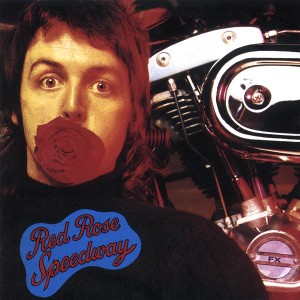
view/request
Sandwiched between the hastily recorded and yet magically off kilter Wild Life and the triumphant, triple platinum Band on the Run album lives a recording called Red Rose Speedway. This second Wings effort bridges the gap between freak outs and radio friendly hits. We find the number one smash “My Love” sitting side by side with the nonsensical jam “Big Barn Red” and the minor key piano ditty “Single Pigeon”. Mac and the gang also attempt a nod to the second side of the Beatles’ Abbey Road with a four song medley. As Alan Partridge once retorted to a person ignorant of McCartney’s second group, “Wings are the band the Beatles could have been.” So very true.
Next week we take a closer look at Ram.
Reviewed by Jason
Tagged: Beatles, Folk music, Pop music, Rock music
McCartney
by Paul McCartney
[Music CD]
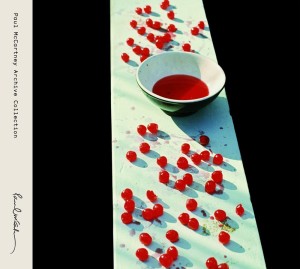
view/request
Paul McCartney’s first solo album, which was certainly unpopular with many critics and his colleagues at the time of its 1970 release, has proven to be an immensely influential and enjoyable, homemade recording. This album was produced mostly at McCartney’s house in London using a simple technique of sending tracks directly into a tape machine. He also performed each instrument himself and the majority of the vocals (some background vocals were sung by Linda McCartney).
Home recording software and portable four-track machines are now sources where many artists, both professional and amateur, record their music. In retrospect, the innovative “McCartney” album was a bold statement that made music making more accessible to those with or without a record contract.
Reviewed by Jason
Tagged: Beatles, Rock music












